 We had a really productive meeting yesterday morning when the Lead Sheducator, Sheducators and Mentors met to familiarise themselves with The Enterprise Shed: Making Ideas Happen and how it will run when it starts next Monday on FutureLearn.
We had a really productive meeting yesterday morning when the Lead Sheducator, Sheducators and Mentors met to familiarise themselves with The Enterprise Shed: Making Ideas Happen and how it will run when it starts next Monday on FutureLearn.
We have a great bunch of people, all experts in enterprise and entrepreneurial thinking, ready and eager to work with learners on The Enterprise Shed: Making Ideas Happen.
Perhaps you have met some of them already?
- Katie Wray is a Lecturer in Enterprise in the SAgE Faculty here at Newcastle University and Lead Sheducator.
- Rebecca Fisher is an Entrepreneurial Development Officer, also at Newcastle University and is both a Sheducator and Mentor.
- Simon Laing is a recent Virgin Startup success story with Cullercoats Bike & Kayak.
- Angela McLean (and her daughter, Jessica McCarthy) recently secured a deal for £100,000 from Dragon’s Den for their Baggers Originals childrens rainwear company.
- Jane Nolan, MBE is a Teaching Fellow in Enterprise with the International Centre for Music Studies in the School of Arts and Cultures and a Visiting Entrepreneur supporting the work of Newcastle University Careers Service. She was awarded the MBE in 2000 for services to UK exports.
- Dr Colin Jones is a Senior Lecturer in Entrepreneurship at the University of Tasmania where he works in the Australian Innovation Research Centre.
- Dr Victoria Mountford is an enthusiastic, entrepreneurial and people-focused individual with a range of experience in (enterprise & employability) higher education, (academic & commercial) research & business development. She works as a Development Officer in the Newcastle University Careers Service.
There will be other enterprising individuals popping up throughout this highly participatory course:
- Professor Sugata Mitra is Professor of Educational Technology at Newcastle University and was given the $1m TED Prize in 2013 in recognition of his work and to help build a School in the Cloud – he tells us more about that.
- We were very excited when Lead Sheducator Katie Wray asked Sir Richard Branson when he visited Newcastle recently what kind of people he thought were entrepreneurial…
Most people ought to be able to become entrepreneurs if they put their mind to it. Sir Richard Branson, 3 March 2014, Northern Stage, Virgin Startup event organised by TEDCO Business Support.
There is still plenty of time to sign up and explore your enterprising side – come and join us in The Enterprise Shed!







 You can watch Angela receive her award (45 minutes and 8 seconds) and see her speech (45 minutes 50 seconds) in the congregation video at:
You can watch Angela receive her award (45 minutes and 8 seconds) and see her speech (45 minutes 50 seconds) in the congregation video at: 

 For a moment, it seems as though all the eyes in the world are focussed on us, just as we are feeling particularly vulnerable, lying on the ground. Given that almost everyone who has ever walked on the earth will have experienced a fall at some point in their life, why is it so embarrassing to fall in public? In fact, we can all probably empathise with someone in this position, having been through it ourselves.
For a moment, it seems as though all the eyes in the world are focussed on us, just as we are feeling particularly vulnerable, lying on the ground. Given that almost everyone who has ever walked on the earth will have experienced a fall at some point in their life, why is it so embarrassing to fall in public? In fact, we can all probably empathise with someone in this position, having been through it ourselves.